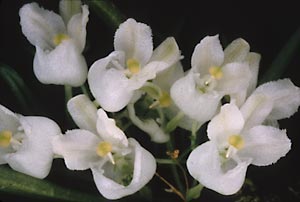

by Marni Turkel / Originally Published in Orchids Magazine
| Hybrid Flask List |
| Orchid Programs |
 Centroglossa macroceras Centroglossa macrocerasGrower: Brad Cotten Photographer: Ron Parson |
Centroglossa macroceras
Some plants have flowers that form so quickly they seem to appear out of nowhere. Others have flowers that you watch for months as they develop ever so slowly. Centroglossa macroceras definitely falls into this latter category. The inflorescence is visible in October, but the plant does not flower until late February or March. All of the six species of Centroglossa are from Brazil.
Centroglossa macroceras, the one most often seen in cultivation, is endemic to the state of Rio de Janeiro in Brazil. Not always easy to find, it is well worth searching out for its sparkling white flowers. It is reminiscent of alpine plants that form compact tufts of foliage that are nearly obscured by blooms in season. The lip of the 3/8-inch (1 cm) flower is saccate (shaped like a pouch or bag) with a club-shaped spur (a hollow tubular extension of the base of the lip) and is crystalline white with green veining that is visible only on the inside. The petals and sepals are green-white to white.
 Centroglossa macroceras Centroglossa macroceras 'Stony Point' CHM/AOS |
In nature, it is recorded as being two-flowered, but in cultivation one can expect two to five flowers per raceme. It is found growing on small-diameter branches where the roots can dry quickly, and this gives a clue to its culture. Centroglossa macroceras thrives with plentiful humidity and a watering schedule that provides a wet-dry cycle at the roots. (The roots should not be kept constantly moist, but allowed to dry between waterings.) Frequency of watering will vary depending on season and method of growing. It performs well mounted on cork or hardwood with a little moisture-retentive material at the roots. Mounted plants may need daily watering in summer and every few days in winter. It can be grown potted in your preferred mix of fine bark with such additives as perlite, horticultural charcoal or tree fern.
The key to growing plants of this species in a pot is to underpot the plant, that is, using a relatively small pot, which limits the amount of potting medium. The specimen plant shown here was grown in a nonporous pot on a block of tree fern with ample air space between the wall of the container and the tree-fern block. This allows the roots to dry between waterings while maintaining humidity. It is made of two little rectangular slabs of tree fern (in this case about 3/4-inches wide × 11/2 inches long × 3/8 inches thick [2 cm × 3 cm × 1 cm]) that get put together like an ice cream sandwich with the roots spread out between the two pieces. The two halves are then secured with fishing line or fine-coated wire. Water it as for other similarly sized potted plants.
Grow C. macroceras in moderate light where a hand held 12 to 18 inches (30 to 46 cm) above the plant casts a diffuse shadow. Water year round and apply dilute fertilizer frequently during the spring and summer, less often in autumn and winter. I grow this plant in a cool greenhouse with minimum winter nights of 52 F (11 C) and days in the mid 70s (21 C). It can also be grown with winter night temperatures in the mid to upper 50s (14 C) and will do well under lights. For both plant health and blooming, good air movement is critical year round.
Mostly Species / Orchids and Flasks | Santa Rosa, CA 95407
© Marni Turkel 2003-2022 All rights reserved